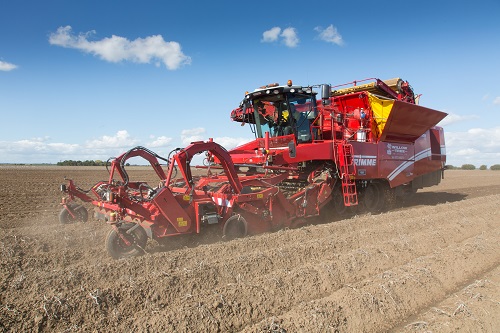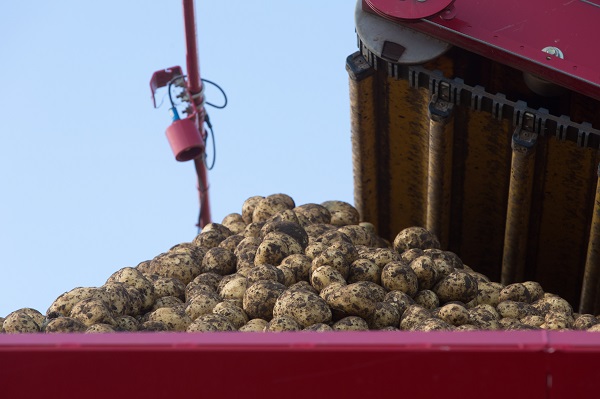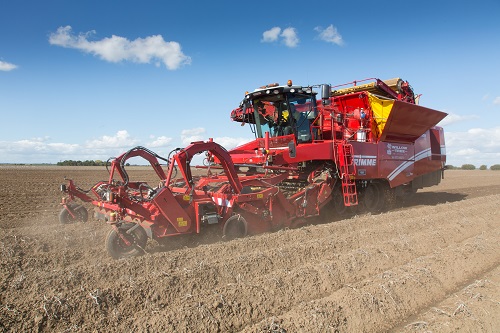
A slow start to the potato growing season has put a dampener on yield and lifting behind schedule. CPM gathers some reports.
It’s going to be a very ordinary year.
By Olivia Cooper
Potato harvest is proving disappointing across much of the country, with below average yields and high levels of wastage. However, later crops are slightly better than earlies, which suffered particularly from the bad weather in June.
According to Arthur Marshall, analyst at AHDB Potatoes, the growing season has been about two weeks behind normal, ever since plantings were delayed with wet weather. “The very first crops were coming off about two weeks later than normal – we got the first buyers’ quotes for new crop around 13 May.”

Wet and cold weather in May and June affected dry matter build in chipping and processing crops, says Arthur Marshall.
May and June were pretty wet, so there were some difficulties getting on the ground, he explains. “It affected crop development, and
farmers couldn’t get blight sprays on either, so blight pressure has been particularly high. Some people have had to burn off corners of fields to control it.”
The wet and cold weather affected dry matter build in chipping and processing crops, so some early crops suffered from low dry matters, says Arthur Marshall. “However, packing crops are broadly good quality. July and Aug also saw better weather so that boosted dry matters.”
Yields have been somewhat mixed, with early yields below average in general. “There were some reports of people not quite making up their contracted volumes, but the later crops have been more variable, with some good and some bad. Which way maincrop yields go will depend on the weather throughout Aug and Sept.”
Lifting conditions have generally been good. Although early lifting was affected by rain, it meant there has been plenty of water available for irrigation over the summer, says Arthur Marshall. “Some growers are irrigating ahead of the harvesters to help avoid bruising and damage when lifting.”
Yields have improved slightly as harvest has progressed, with early yields below average and later crops moving closer to the farm average. Quality concerns have included the usual cases of bruising, blackleg, growth cracks and wet rot, with unirrigated crops senescing early, he adds.

Despite a slightly higher planted area, below average yields will result in a 3% decrease in production
In Yorks, Sagitta and Panther were yielding around 37-40t/ha towards the end of Aug, with the best Marfona in Suffolk and Essex reaching 60t/ha. “Waste is mainly growth cracks and greening, with some break down reported in bagged samples due to the immaturity of some crops combined with high field heat,” says Arthur Marshall. In some places, extensive irrigation has been necessary to maintain moisture levels and assist bulking, with reports of low tuber counts in the South and Scotland.
According to the AHDB’s provisional planting estimate, growers set 116,000ha of potatoes this year – 4% up on last year but still the second lowest area on record. Given that yields are below average, compared with last year’s bumper yields, total production is likely to be down. “If a five-year average yield (including 2012) of 45.2t/ha was achieved, this would result in a 3% decrease in production,” says Arthur Marshall.
Maris Piper continues to be the most popular variety, with a 5% increase in area, year-on-year. “As a versatile variety, this could be related to the higher area intended for both the chipping and packing markets,” he explains.
Newer varieties have grown in popularity, with Taurus (crisping) up 32%, Royal (processing) up 38%, Brooke (crisping) up 114% and Nectar (packing) up 49%. In contrast, Lady Rosetta (crisping), Hermes (crisping), Harmony (packing), Estima (packing) and Markies (processing/chipping), all continued their decline.
Richard Solari, who grows 100ha of potatoes at Heath House Farm, Beckbury, Shrops, has been experimenting with a few new varieties alongside the old favourites. About a third of his area was down to early varieties Accord and Miranda, with another third growing second earlies and chipping varieties, and the final third for packing.
“The Accord was very good quality, but the Miranda and Ramos had quite a lot of waste, with greening and growth cracks,” he says. “Yields have been 10-15% below average – so compared with last year they’re 20-30% down. With the disappointing prices now, it’s going to be a very ordinary year.”
Test digs on Divaa and Eurostar indicate that their waste levels will be better, with the Maris Piper looking to be good quality, adds Richard Solari. “Harvest is running a couple of weeks late – by 25 Aug we’d lifted 45ha. Chipping yields are still below average, and I think the Piper will be down, too, although by how much is hard to tell until we get into it.”
Richard Solari attributes the lower yields to the lack of sun – something which also resulted in the worst winter barley yields he has ever had. “We also had a cool May, so the potatoes didn’t get going early on. They looked fantastic up to the point of flowering, but irrespective of variety they’ve gone off very quickly, which I’ve never seen before. They were very happy and suddenly then they weren’t.”
Despite some high blight pressure earlier in the season, Richard Solari managed to keep on top of it at great expense. He’s also seen some blackleg, but is relieved to be on light land. “On heavier land there’s been a lot of rot where the crops were just sitting in wet soil.”
In the East of England farmers have been two to three times worse off, with even higher levels of waste and senescence, following the wet June, he adds. “Usually it takes us two or three weeks to fill an artic-load of waste – now it’s one a week as we’re getting 20% waste levels. Even so, in the East I’ve heard of waste levels up 80%; it’s a complete write-off.”
Independent agronomist Simon Faulkner, of SDF Agriculture, says wastage from greens and growth cracks are amounting to 10-15% on their own in the East. Hollow heart has also been a problem, although common scab hasn’t been as bad as expected. “Blight was a big issue in June and July, but people have managed to get on and keep it in check,” he says.
By the end of Aug, growers in Suffolk and Norfolk were mainly lifting early crops, with farmers in south Lincs just making a start on salads. “Quality is very much a mixed bag – we’re seeing everything from good to poor,” says Simon Faulkner. “Early and maincrop yields will probably be 10-15% down on last year due to lower tuber numbers, although salads have a much shorter growing season and will likely be on par with last year.”
Simon Faulkner attributes the lower yields to the poor June weather. “Sunlight levels were very low – we lost a month of growth at a key time. Aug has been better but the days are getting shorter,” he explains. “The second earlies are naturally senescing, but I think the later maturing crops will probably benefit.”
Processors have been concerned over crop quality, particularly in the earlier crops, he adds. “They had a very difficult start to chipping, with low dry matters and size.”
And it’s been a similar story in Europe. “French yields are down and prices are strong there already,” says Simon Faulkner. “There’s been high blight pressure and high temperatures recently which has stopped potatoes from growing.”




